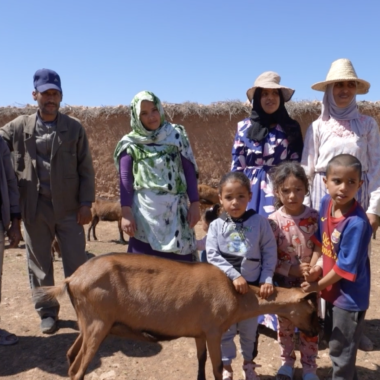Balanced fertilization: a fulcrum for sustainable production of maize and rice in Africa
A new benchmark analysis of nutrient omission trial data provides new guidance on the predictors of yield in smallholder maize and rice cropping systems in sub-Saharan Africa.
Efforts to improve the yields of staple cereal crops like maize and rice at scale in Africa remain seriously hampered by the effects of poor soil fertility. The lack of adequate information to base an effective fertilizer recommendation upon often results in inefficient nutrient use by crops and low crop yields. A root cause of poor crop response to applied nutrients is generalized fertilizer recommendations that fail to account for variability in factors such as the climate, soil properties, and water availability. As we improve our understanding of the range of underlying issues that interact to create variability, better solutions can be created for farmers, and confidence in fertilizer use will grow.
“While increased fertilizer use is necessary to improve cereal crop yields in nutrient depleted soils in SSA, frequent occurrences of low and variable crop yields following increased fertilizer applications limit the use of fertilizers by smallholder farmers.”
Over the last 20 years, nutrient omission trials (NOTs) have become a widespread method of assessing crop responses to nutrient application within defined agro-climatic landscapes or even an individual farm field. NOTs are designed as a series of plots that omit single nutrients in order to isolate the effects of their absence on crop growth and yield. Plots omitting nutrients are also compared to plots providing a more balanced application of nutrients that attempt to achieve a predetermined yield target based on a current understanding of crop nutrient demand.
The NOT technique is particularly adaptable to the fragmented landscape of smallholder agriculture. The use of NOTs provides a means to collect site-specific data on crop nutrient responses and soil nutrient supply and provide data essential for generating more targeted fertilizer recommendations. Additional motivation behind the development of the science supporting NOTs is that the method shows high promise as a scalable tool to replace long-standing generalized recommendations systems.
Recently, an analytical review of NOT studies conducted in SSA, published in Agronomy for Sustainable Development, has provided new insight into the causes of yield-robbing variability. The team of researchers began by collecting primary data from more than 3,000 NOTs conducted for maize (35 regions from seven countries) and rice (30 regions from 17 countries) in order to gather evidence on the most influential factors limiting these crop yields and gain a better understanding on why and to what degree yield responses vary across the landscape.
“Ultimately, the team was searching for actionable information to improve nutrient management for sustainable crop production intensification in SSA and identify future nutrient management research and development priorities that can help breakthrough existing knowledge gaps that are preventing yield improvement at scale. The results of the analysis provide valuable insights into the role of balanced fertilizer in improving the performance of cropping systems as the continent prepares for the Africa Union-led 2023 Africa Fertilizer and Soil Health Summit,” explains corresponding author and Director of Research and Development at the African Plant Nutrition Institute, Dr. Shamie Zingore.
The review provides a comprehensive look at the overall effects of nutrient application on yields and nutrient use efficiency in maize and rice, how yields vary across the landscape, and what are the best predictors of yield and yield response.
Highlights from the study
Results determined that balanced fertilization with nitrogen, phosphorus, and potassium (NPK) doubled both maize and rice yields (i.e., from 2 to 4 t/ha) compared to current practice. Yet the analysis indicated that farmers could expect more consistency across their fields, and season-to-season, if NPK applications were combined with other macro and micronutrients, or farmyard manure inputs. The author’s point to an existing African Green Revolution target of 3 t/ha that would be more likely to be exceeded by farmers adopting this latter, more balanced fertilization approach.
Critical to our knowledge, the study also details new insights on how, why, and to what degree maize and rice yield responses are expected to vary in SSA. Factors such as soil type, agroclimatic zone, crop variety, and nutrient imbalances are identified and ranked in terms of importance within the cropping systems. Nutrient imbalances of calcium (Ca), magnesium (Mg), and K were identified as playing a large role in limiting yield responses to N and P application in SSA soils. Of specific note, is the authors recommendation to revitalize research efforts towards understanding why soil K responses vary widely across maize and rice cropping systems. In their concluding remarks the authors make a convincing case for revitalizing work on unravelling the site-specific interactions between K and other nutrients, as well as the role of K fixation, as two key areas of research needed to generate consistently high yields at scale.
Acknowledgment
This summary was extracted from the article published by S. Zingore, I.S. Adolwa, S. Njoroge, J-M. Johnson, K. Saito, S. Phillips, J. Kihara, J. Mutegi, S. Murell, S. Dutta, P. Chivenge, K.A. Amouzou, T. Oberthur, S. Chakraborty, G.W. Sileshi. 2022. Novel insights into factors associated with yield response and nutrient use efficiency of maize and rice in sub-Saharan Africa. A review https://doi.org/10.1007/s13593-022-00821-4
The team of researchers involved in this study represent the African Plant Nutrition Institute (APNI), Benguérir, Morocco, Nairobi, Kenya, Yamoussoukro, Côte d’Ivoire; Africa Rice Center (AfricaRice), Bouake, Côte d’Ivoire; International Center for Tropical Agriculture (CIAT), Nairobi, Kenya; Agricultural and Food Engineering Department, Kolkata, India; Department of Plant Biology and Biodiversity Management, Addis Ababa University, Addis Ababa, Ethiopia; School of Agricultural, Earth and Environmental Sciences, University of KwaZulu-Natal, Pietermaritzburg, South Africa.





